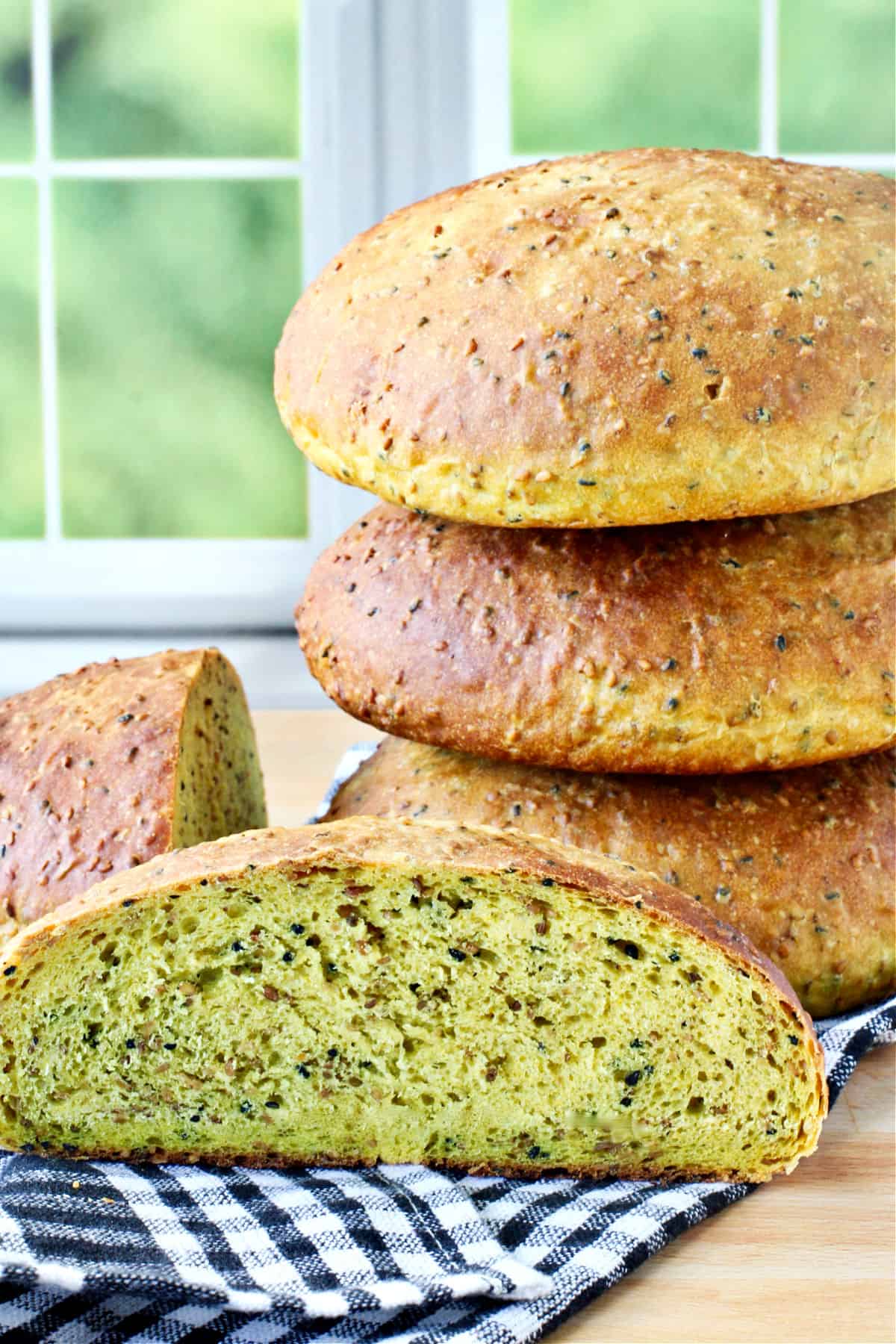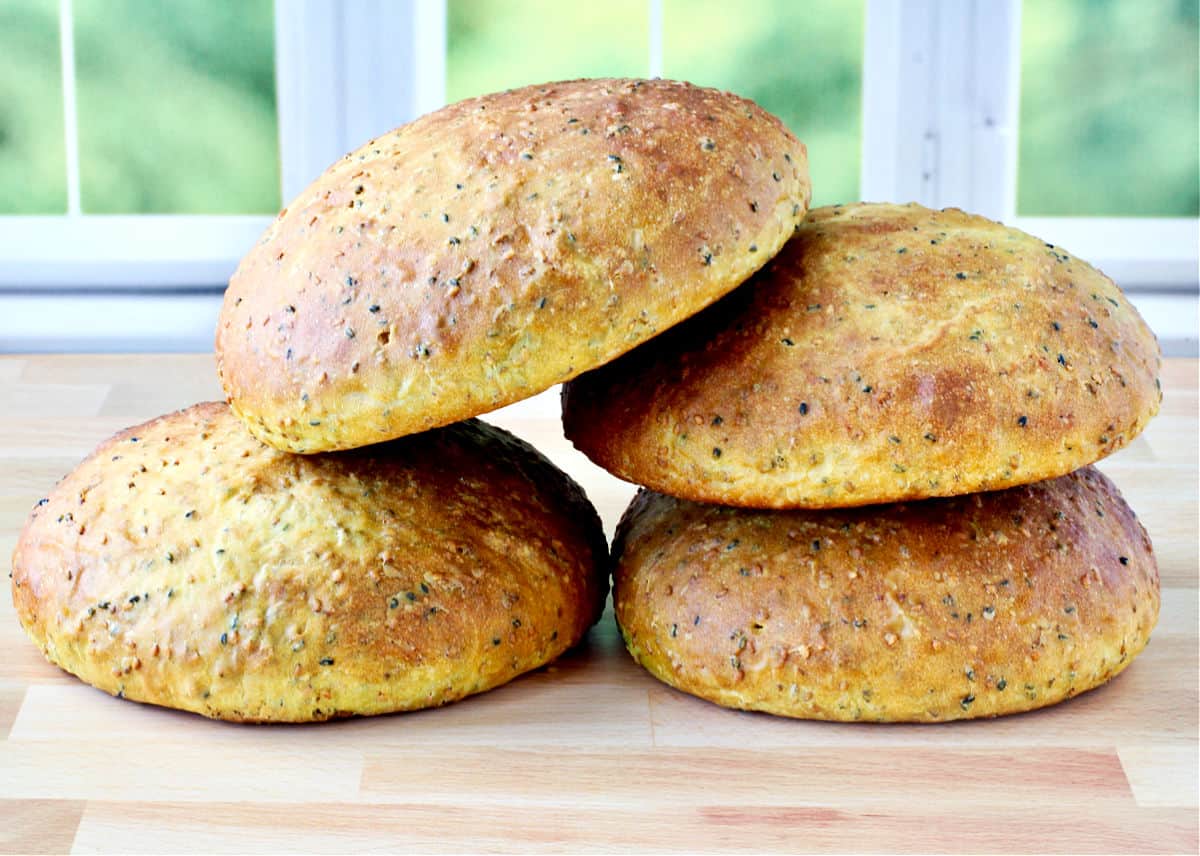It's not easy to describe the delicious flavor of this ka'ak asfar. This bread is slightly sweet but the sweetness is counter-balanced with the savory flavors of various seeds and spices.
These little loaves are soft, round, and sort of flat, but still sliceable for spreading and dipping.
Traditionally, this bread is associated with Easter in the Holy Land, often served with hard-boiled eggs (what we call Easter eggs) and possibly labneh, a thick, strained yogurt.
It is also sometimes served with creamy cheeses, jam, and/or green olives as part of a plate (like jachnun). We simply enjoyed it buttered, with soup, toasted with cheese or jam, and for making sandwiches.
This bread is often baked with a geometric pattern on top that is pressed into it from a ka'ak stamp. While I was tempted, to buy one, I already have too many specialty patterned stamps (for Uzbek bread), rolling pins (for Hällakakor, lefse, and even homemade Oreos), and cookie stamps. I once even bought a Kaiser roll stamp but gave it away when I learned how to shape my own Kaiser rolls. For once, I resisted!
I used my fingers to dimple the tops of the rolls but the dimples disappeared as the flatbreads rose in the oven. If you want to make this dough into a flatter shape, you can use a fork to pierce it before placing the breads in the oven.
Ingredients in This Bread:
Turmeric: Ka'ak Asfar gets its color from turmeric, a golden spice made from a plant from the ginger family. The flavor is kind of earthy and slightly sweet. A little goes a long way when it comes to the color. There is only one teaspoon of ground turmeric in almost five cups of flour used for making these loaves.
It's commonly used in curries, rice dishes, soups, stews, and breads. I've used it in Sfoof, a Lebanese bread, turmeric shrimp, shrimp biryani, and even aloo tikki (an Indian potato dish).
In addition to turmeric, this bread is loaded with lots of various seeds.
Nigella Seeds: Nigella seeds have sort of a savory, oniony, peppery, herbal flavor, which is unique to these seeds. They are actually mentioned in the Old Testament and are said to have been found in King Tut's tomb. They look like black sesame seeds and are great to incorporate in breads, crackers, bagels, and even muffins. They are thought to be quite nutritious. You can usually find them in Middle Eastern markets. If you can't find them, you can skip them and still make this bread.
Toasted Sesame Seeds: You can either toast them yourself or buy pre-toasted sesame seeds in the Asian section of your grocery store.
Aniseed: It contributes a mildly sweet licorice type (but not too much) flavor.
Mahlab (or Mahleb): This spice is made from the pit of the St. Lucie cherry and tastes a bit like bitter almond. If you can't find it, you can replace it with almond extract.
Extra Virgin Olive Oil: Be sure to use a fruity flavored quality oil for this bread.
Note: I keep all of my seeds in the freezer to prevent them from spoiling.
Procedure:
This bread is so easy to make.
Before you mix everything, grind the seeds, with the exception of the sesame seeds, briefly in a mortar and pestle or in a spice grinder. Don't pulverize the seeds. Grind them just enough to release some of the flavor.
Next, combine all of the ingredients in the bowl of a stand mixer and knead with the dough hook for about 10 minutes.
Let the dough bulk rise for about an hour, until doubled, and then divide it into four pieces. Shape the pieces into balls, flatten them a bit, and then let them rise until doubled again before baking for about 20 minutes.
This recipe was adapted from the Milk Street television show on PBS. They enlisted the help of Reem Kassis, the author of The Palestinian Table Cookbook, to help develop this recipe. She also has a version of this bread on Serious Eats, but shaped like a bagel.
In her book, she also has a recipe for crackers using all of the seeds used in this bread. They are definitely on my list to make.
Breads from the Mediterranean:
This month, the Bread Bakers are sharing breads from the Mediterranean region, which includes countries from Southern Europe, North Africa, and Western Asia, all of the countries that surround the Mediterranian Sea. The variety of breads from this region is endless, from pitas, lavash, focaccia, pizza, Easter breads, and a huge variety of flatbreads.
- Bazluma from Magical Ingredients
- Cheese Fatayer from Sneha's Recipe
- Egyptian Mahlab Bread from Food Lust People Love
- Halloumi Cheese, Olive, and Mint Bread from Cook with Renu
- Ka'ak Asfar from Karen's Kitchen Stories
- Olive Oil Blueberry Muffins from A Day in the Life on the Farm
- Pita from Passion Kneaded
- Scones with Za'atar and Feta from Palatable Pastime
- Sourdough Man'oushe (Za'atar Flatbread) from Zesty South Indian Kitchen
- Vasilopita from A Messy Kitchen
More of my Favorite Mediterranean Breads:
... not to mention so many breads from Southern Italy and France.
Ka'ak Asfar (Palestinian-Style Turmeric Bread)

Ingredients
- 618 grounds (4 3/4 cups) all purpose flour
- 71 grams (1/2 cup) toasted sesame seeds
- 100 grams (1/2 cup) granulated sugar
- 1 tablespoon instant yeast
- 3 tablespoons aniseed, coarsely ground
- 3 tablespoons nigella seeds, coarsely ground
- 1 teaspoon turmeric powder
- 1 teaspoon salt
- 1/2 teaspoon mahlab (or 1/4 teaspoon almond extract)
- 1 2/3 cups warm (about 100 degrees F) water
- 1/2 cup extra virgin olive oil, plus a bit more for shaping
Instructions
- In the bowl of a stand mixer, whisk together the flour, sesame seeds, sugar, yeast, aniseed, nigella seeds, turmeric, salt, and mahlab.
- Combine the water and olive oil in a large measuring cup.
- Turn the mixer, fitted with the dough hook, on low and slowly add the water and oil to the mixer.
- Knead the dough on medium low for 10 minutes, scraping down the sides of the bowl if necessary.
- Place the dough into an oiled dough rising bucket or bowl, cover, and let rise until doubled, about an hour.
- Heat the oven to 400 degrees F. and line a half-sheet pan or cookie sheet with parchment paper.
- When the dough has doubled, divide it into four equal pieces and shape each into a round and place them, seam side down, on the parchment spaces as far apart as possible. Press the rounds into 5 inch disks. Dip your fingers in olive oil and dimple the disks as you would focaccia. Cover with oiled plastic wrap and let rise until doubled, about 30 minutes.
- Bake the rounds for about 20 minutes. Cool on a wire rack.
Nutrition Facts
Calories
106Fat (grams)
4 gSat. Fat (grams)
1 gCarbs (grams)
15 gFiber (grams)
1 gNet carbs
14 gSugar (grams)
3 gProtein (grams)
2 gCholesterol (grams)
0 mgHow to stay up to date with Karen's Kitchen Stories?
While you’re here please take a minute to follow me on Pinterest. I’m always pinning great recipes from fellow bloggers.
Finally, please follow me on Instagram. It’s a great way to stay up to date on all the latest and greatest blog recipes.









I may just put this bread on my Easter menu this year. It sounds delicious Karen.
ReplyDeleteI hope you like it!
DeleteWhat gorgeous little loaves, Karen! I love their color and all the spices in the dough. Truly exceptional!
ReplyDeleteThank you so much!
DeleteThis is beautiful loaves, I need to try this I like the addition of Mahlab, turmeric . Love the color too.
ReplyDeleteThank you!
DeleteAnother one calling my name, Karen!!!!!
ReplyDeleteI think you'd like the flavor!
DeleteThat's a wonderful bake! I love the color and flavor profile of this bread. I haven't used mailed at all and now I am, placing an order to bake this bread.
ReplyDeleteGlad I could tempt you!
DeleteWhat a unique combination of flavors! I am intrigued because I love all the separate parts but never thought of mahlab as savory, and although I know turmeric does well in sweet, this recipe totally surprises me!
ReplyDeleteIt's a really interesting combination Kelly.
DeleteThese breads are real beauties', naturally colored and with seeds in it!
ReplyDeleteWhat a stunning loaf this is Karen. Love the combination of spices, seeds in this bread and needless to say the colour.
ReplyDeleteDo you have any experience with using gluten-free flour, such as almond flour when making this bread? If so, do you recommend any changes to the amounts?
ReplyDeleteI'm sorry, I don't. If you were going to try it, I'd use King Arthur's GF flour.
Delete